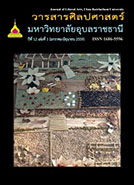ความเชื่อร่วมเรื่องเครื่องรางของขลังในเมืองชายแดน ไทย-ลาว-กัมพูชา
Main Article Content
บทคัดย่อ
ผลการศึกษาพบว่าทั้งคนไทย ลาวและกัมพูชา ต่างมีความเชื่อพื้นฐาน เกี่ยวกับเครื่องรางร่วมกันคือ มีความเชื่อเกี่ยวกับเครื่องรางประเภทเขี้ยว งา เขา ตลอดจนเครื่องรางที่มาจากสัตว์ชนิดอื่นๆ รวมทั้งเครื่องรางจำพวกว่านยาและ แร่ธาตุ เครื่องรางที่เป็นเครื่องมือหาเลี้ยงชีพ นอกจากนี้ยังมีเครื่องรางเกี่ยวกับ ความเชื่อท้องถิ่นที่ผสานกับความเชื่อทางศาสนา ในตลาดการค้าเมืองชายแดนเครื่องรางเหล่านี้ดำรงอยู่ในสถานะที่คาบเกี่ยวกันระหว่างความเป็นเครื่องรางและ ของที่ระลึก ซึ่งมีความเชื่อมโยงกับวาทกรรมเกี่ยวกับถิ่นกำเนิดเช่นเดียวกับของที่ ระลึกอื่นๆ โดยเฉพาะวาทกรรมเกี่ยวกับความเป็นดินแดนซึ่งยังคงความ อุดมสมบูรณ์ของป่าเขาและวิถีแบบดั้งเดิมของลาว และความเป็นผู้เชี่ยวชาญทาง ไสยศาสตร์ของเขมร ในส่วนของเครื่องรางโบราณ 5 ชนิดซึ่งเป็นจุดเน้นของ งานวิจัยคือ งั่ง อิ่น เป๋อ พระกริ่งเขมร และพระปิดตา พบว่าเครื่องรางในกลุ่มงั่ง อิ่น เป๋อ นั้นมีคติดั้งเดิมที่เชื่อมโยงกับคติความเชื่อในศาสนาพราหมณ์ ส่วน พระกริ่งและพระปิดตา เป็นความเชื่อที่แพร่หลายในวัฒนธรรมพุทธ ผลการศึกษา ในประเด็นนี้พบว่า งั่งเป็นรูปแทนของพระศิวะ แม่เป๋อเป็นรูปแทนของพระอุมา ส่วน อิ่น ก็คือเครื่องรางที่แสดงการสวมกอดแสดงความรักใคร่กันระหว่าง พระศิวะกับพระอุมา ส่วนพระกริ่งนั้นแม้ว่าคติดั้งเดิมในการสร้างจะหมายถึง พระไภษัชยคุรุฯ พระพุทธเจ้าผู้ทรงคุณวิเศษในทางรักษาโรคตามคติมหายาน แต่ เมื่อได้แพร่กระจายสู่ถิ่นอื่นความหมายด้านบุคคลของพระกริ่งก็อาจผันแปรไป ตามองค์พระที่นับถือในแต่ละท้องถิ่นและแต่ละยุคสมัย เครื่องหมายคล้ายเลข หนึ่งไทยที่มักปรากฏที่ใต้ฐานพระกริ่งเขมรอาจสืบค้นได้ว่าสื่อถึงความเป็นปฐม กำเนิด ดังนั้นตามคติแต่ดั้งเดิมในดินแดนแถบวัฒนธรรมร่วมไทย ลาว เขมร ความหมายด้านบุคคลของพระกริ่งเขมรโบราณอย่างพระกริ่งหน้าตั๊กแตนจึงอาจ หมายถึงพระพุทธเจ้าองค์ปฐม อย่างไรก็ตามในบางท้องถิ่นโดยเฉพาะที่ปรากฏใน ยุคปัจจุบันพระกริ่งหน้าตั๊กแตนก็อาจถูกสร้างให้หมายถึงพระอุปคุต องค์พระซึ่ง เป็นที่รู้จักกันในท้องถิ่นอีสานในนามพระผู้มีอิทธิฤทธิ์ผู้คอยคุ้มครองงานบุญ ผะเหวด ส่วนกรณีของพระปิดตาอาจสันนิษฐานได้ว่าความเชื่อในคติดั้งเดิมคือ พระพิฆเนศหลังถูกแปรให้เป็นเทพผู้ปกปักรักษาพระพุทธศาสนา
The objective of this research aims to study the shared beliefs on amulets in the borderlands of Thailand, Laos and Cambodia. Two topics will be explored: firstly, the perception of the amulets in the context of relating contemporary culture ; and secondly, the local beliefs on the amulets before the contemporary era. The field research, exploring amulets which form shared beliefs, aims to collect data and to analyze the beliefs relating to five types of ancient amulets: Ngang (งั่ง), In (อิ่น), Poe (เป๋อ), Khmer Phra Kring (พระกริ่งเขมร), and Phra Pit Ta (พระปิดตา). The research methods in folklore were applied to the data collection in border markets and temples in the Thai–Lao–Cambodian boderlands of the provinces of Ubon Ratchathani, Sisaket, Surin, and Champasak.
The results of the study show as follows. Firstly, the Thai, Lao, and Cambodian societies have common beliefs on the amulets made of animal canine teeth, horns, elephant tusk, and other animal products. Moreover, these amulets can cover various types of medicinal herbs, minerals, basketworks, and sacred objects unifying between local and religious beliefs. In terms of social perception of the amulets, in Thai, Lao and Cambodian borderland societies accept that these talisman objects have a dual social status combining between amulets and local souvenirs. The mechanism of mass culture is the popular discourse on the abundance of Lao natural resources and Cambodian magic and mysticism. Secondly, in terms of local beliefs on amulets before the contemporary era in the borderlands of Thailand, Laos and Camodia, it’s found that five types of amulets among those were studied: Ngang (งั่ง), In (อิ่น), Poe (เป๋อ), Khmer Phra Kring (พระกริ่ง เขมร), and Phra Pit Ta (พระปิดตา). The first three amulets can be traced back to the Brahmanism influence while the last two amulets relate to the popular culture of Buddhism. The Ngang can refer to a Hindu god called Shiva, the Poe to a Hindu goddess called Uma, and the In to the fusion of Shiva and Uma. The meaning of Phra Kring, originally believed to be a representative of Bhaisatchaya Guru, one of Mahayana Buddhas, has been interpreted in a variety of ways, depending on the period of time and geographical areas. However, the numeric symbol similar to Number One in Thai (๑), which is always found under the base of the Khmer Phra Kring amulet, could be referred to as initial birth. Therefore, based on original beliefs in the shared cultural areas of Thailand, Laos, and Cambodia, Phra Kring, especially the one with a grasshopper-shaped like face, could mean the first Buddha. Nevertheless, this type of Phra Kring, in some areas, could basically be created to refer to Phra Upaguta, which means the protector. And Phra Pit Ta can be traced back to the god Ganesavara who was interpreted as the protector of the Buddhism.


